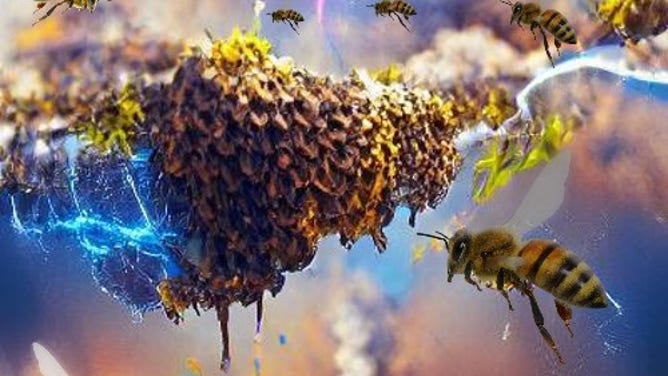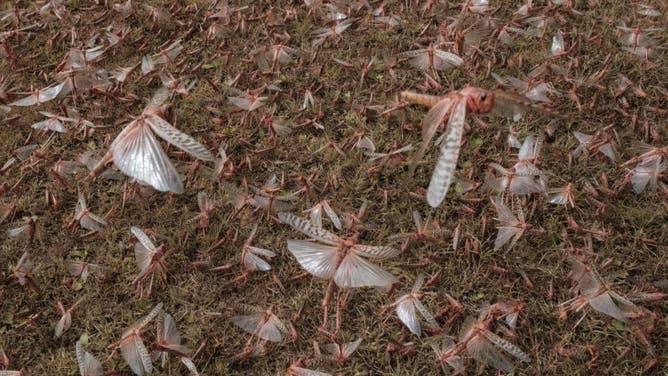Swarming insects can create an atmospheric charge comparable to storm-producing clouds, study shows
By using instruments that measure meteorological conditions, the researchers were able to compare insect swarms to clouds and other weather phenomena.

An AI rendered image of a honeybee swarm and atmospheric electricity. (Image credit: Ellard Hunting/University of Bristol)
Lightning is a huge spark of electricity between Earth’s atmosphere and the ground, but what about thousands of tiny charges closer to the ground? A new study found that swarms of honeybees produce as much electricity as a storm cloud.
Published by researchers at the University of Bristol and the University of Reading in the journal Science, the study is part of a relatively new field of study known as electric ecology, which examines electricity in biology from the organismal level up to the environment.
"We think about how animals are able to take physical information from the environment and process that. And so we always think about how the physics influences the biology, but it's actually really nice to now flip that and say, ‘well, now the biology is influencing the physics," study coauthor Liam O’Reilly explained.
The first measurement was taken by pure chance when a beehive became overcrowded, and a swarm and its queen moved over an electric field mill near the hive to measure the honeybees.
"We noticed an increase of about a thousand volts per meter on our measurements," O’Reilly said. "We knew from our previous data and from previous studies that flying insects, including bees, have a charge."
They already knew that bees have static electricity individually, and as they fly through the air, they lose electrons, becoming positively charged.
RECENTLY DISCOVERED 'SEA BUGS' CAN GROW UP TO 1.5 FEET, EAT ENTIRE ALLIGATOR CORPSE
"It makes sense that a swarm, a group of these individuals with charge, would provide a larger charge and then an effect on the local electric field," he said.
The researchers determined the insects' electric charge contribution to the atmospheric electricity varied by how many insects were tightly packed in a swarm or its density.
"We thought, ‘well, this is really interesting, but what other insects that swarm?" O’Reilly said.
Find the charge density for locusts

A picture taken on February 9, 2021, shows a swarm of desert locust covering the ground in Meru, Kenya. (Photo by Yasuyoshi CHIBA / AFP) (Photo by YASUYOSHI CHIBA/AFP via Getty Images)
(Getty Images)
The team would wait another year for the bees to swarm again to take another measurement, but they measured locusts, European Peacock butterflies and cinnabar moths in the meantime.
When you think of a swarm, locusts best known for "biblical" swarming events that destroy crops and create havoc may be the most well-known swarm insects in history.
"Some of the locust swarms, it's like 460 square miles with 40 to 80 million locusts in less than half a square mile. So it's quite a huge event," O’Reilly said.
For ethical reasons, the research team did not want to create a swarm of locusts, so those measurements were taken in a lab environment using wind tunnels, measuring the individual charges of the insects and then averaging the values. Using already available locust swarm density data, the researchers came up with a charge density measurement, similar to what atmospheric scientists use to describe clouds and dust storms.
"We start off with this sort of chance measurement and then get a bit more information by setting up and getting the swarm density and then getting that correlation. And then through very basic modeling, we're able to compare that to meteorological phenomenon," O’Reilly said.
HOW TO WATCH FOX WEATHER ON TV
Using instruments that measure meteorological conditions, including electric field mills and Faraday pails, the group could compare these swarms to clouds and other weather phenomena.
The researchers compared the insect swarm charges to semi-fair-weather clouds, storm clouds and electrified dust storms. They found that locust swarms can produce enough charge that exceeds electrical storm clouds.
Meanwhile, moths and butterflies with much lower densities do not produce substantial sources of atmospheric charge, but, according to the study, in some extreme swarming events, the insects could be comparable to fair-weather clouds.
O’Reilly stresses that these flying insects can’t produce weather events like lightning.
"Insect swarms accumulate some static charge, and this has a density-dependent effect on the local atmospheric electric field, and the scale at which it has this effect is similar to meteorological phenomena such as clouds or dust storms," O’Reilly said.
CLICK HERE TO GET THE FOX WEATHER UPDATE PODCAST
However, before you get concerned about getting zapped by a honeybee swarm, there is an important distinction to note: distance and scale.
"This is a small honeybee swarm, for instance, very close to the sensor compared to a large thundercloud, perhaps, which is kilometers away," O’Reilly pointed out.
The lab group hopes to continue gathering more swarm measurements, including locusts, to learn how they affect atmospheric electricity measurements.